#chinese american history
Text

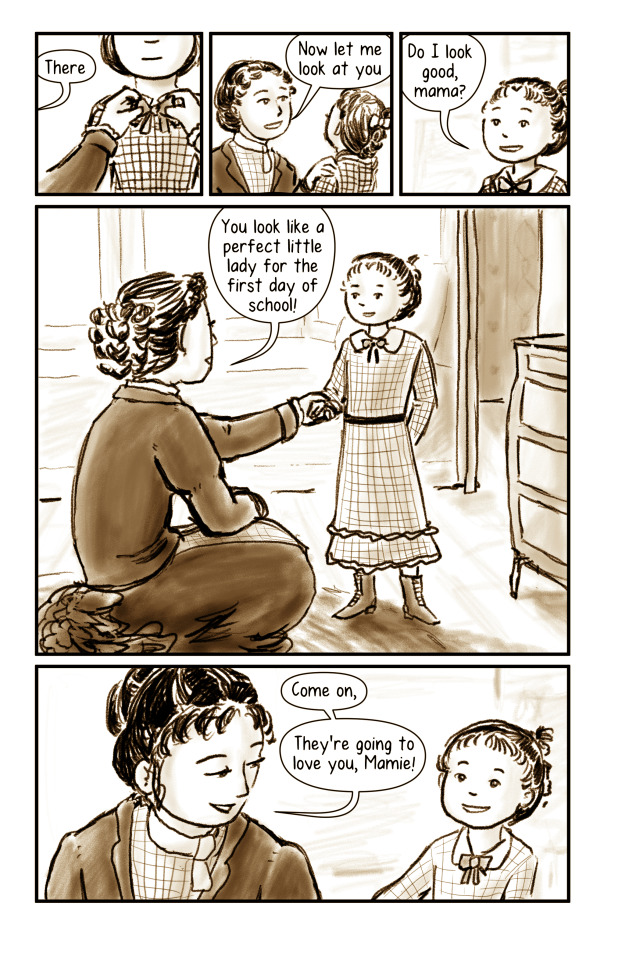
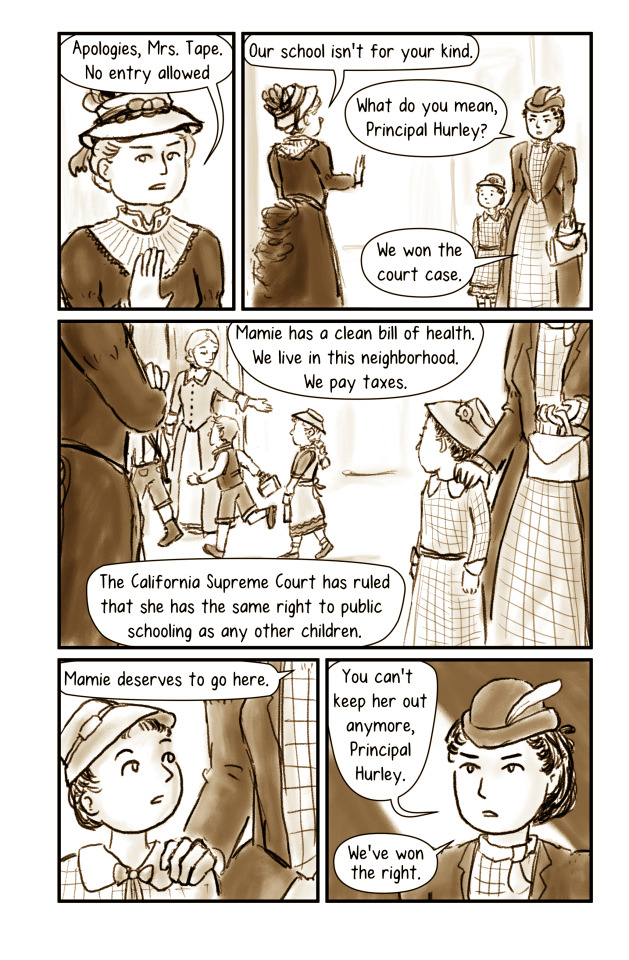
in my pursuit of ever-increasingly niche comics, I drew a 13 page comic about Tape v Hurley, a court case about Chinese-American school segregation in 1885. The rest of the pages are after the readmore, as well as on AO3 here. More obsure Chinese American court case comics are there, as well.

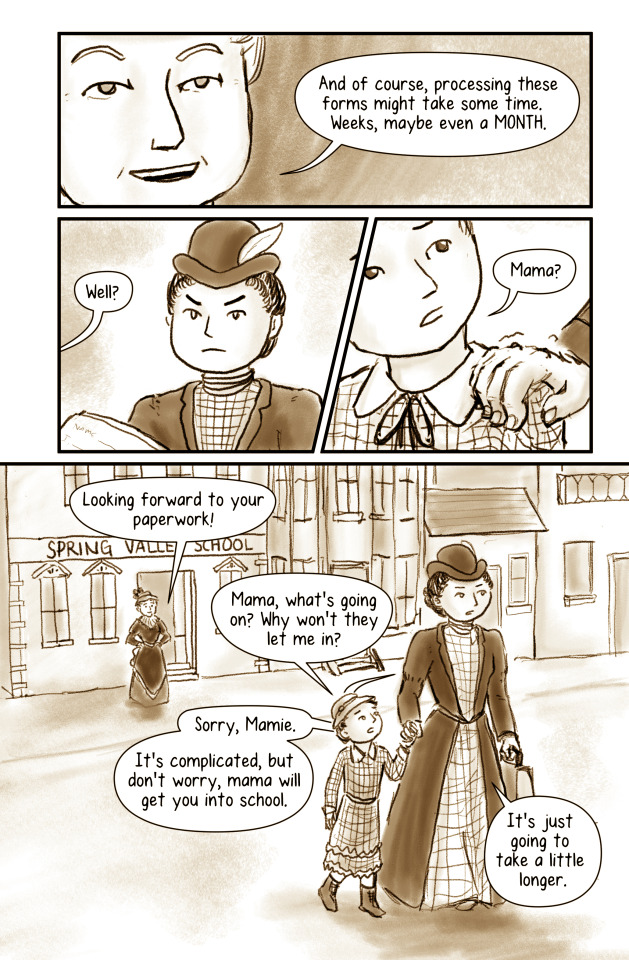
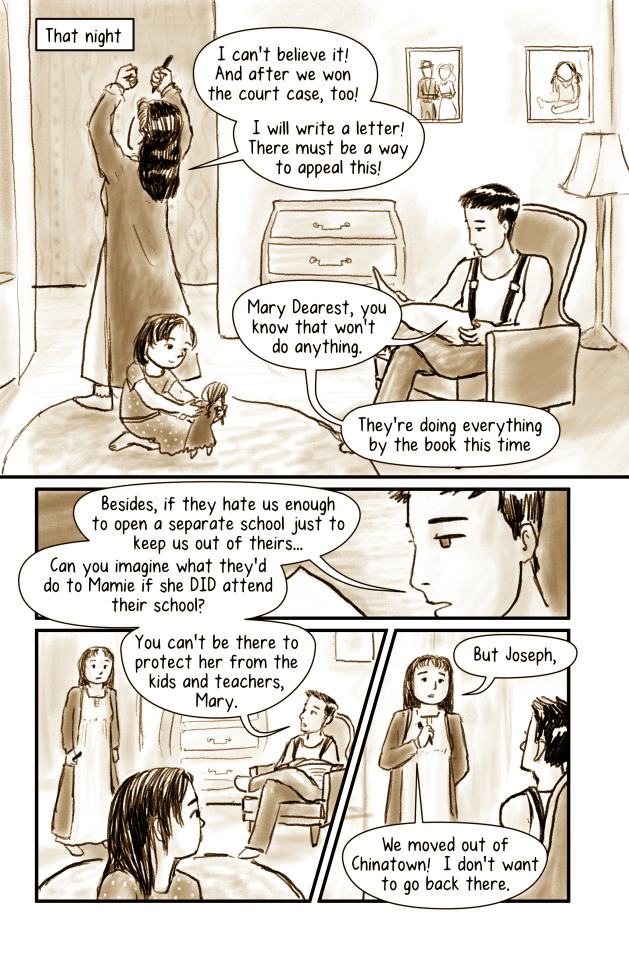
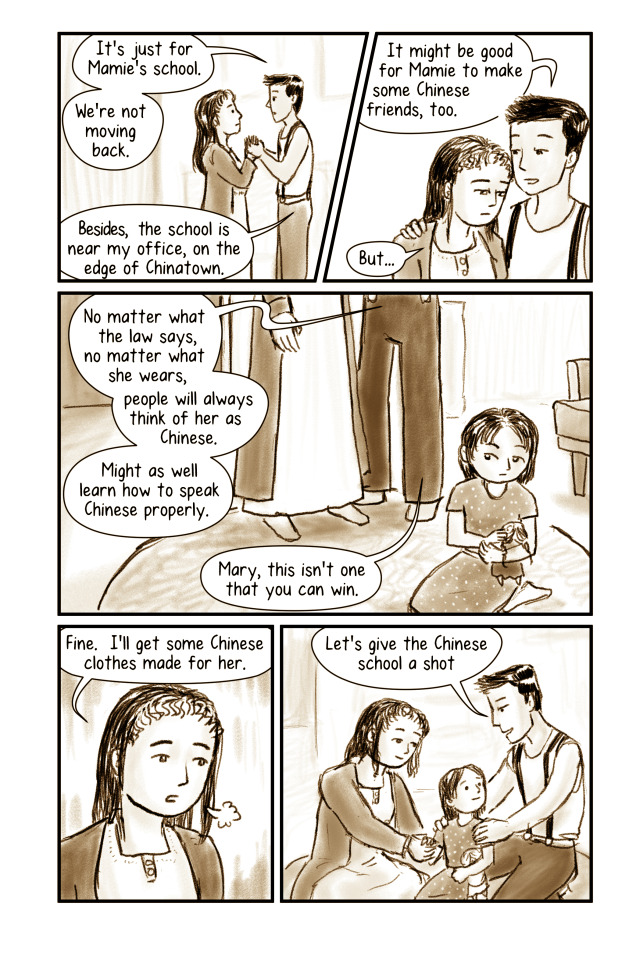
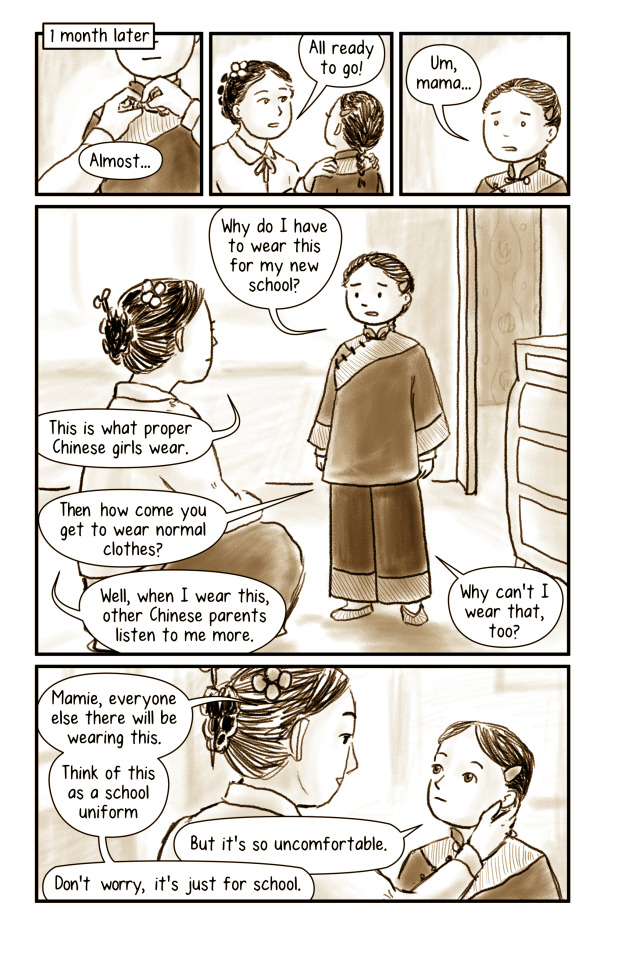
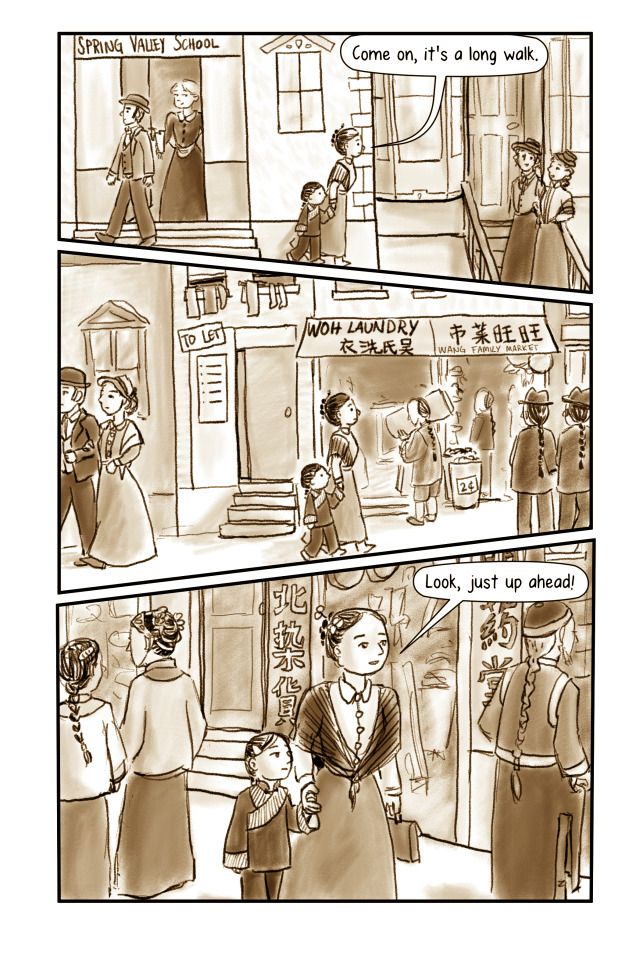
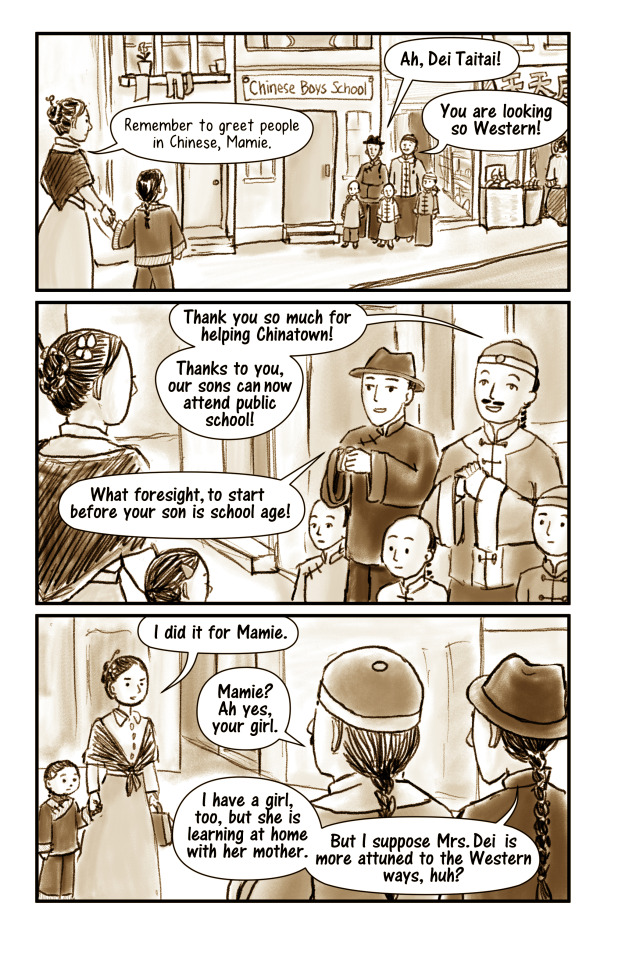
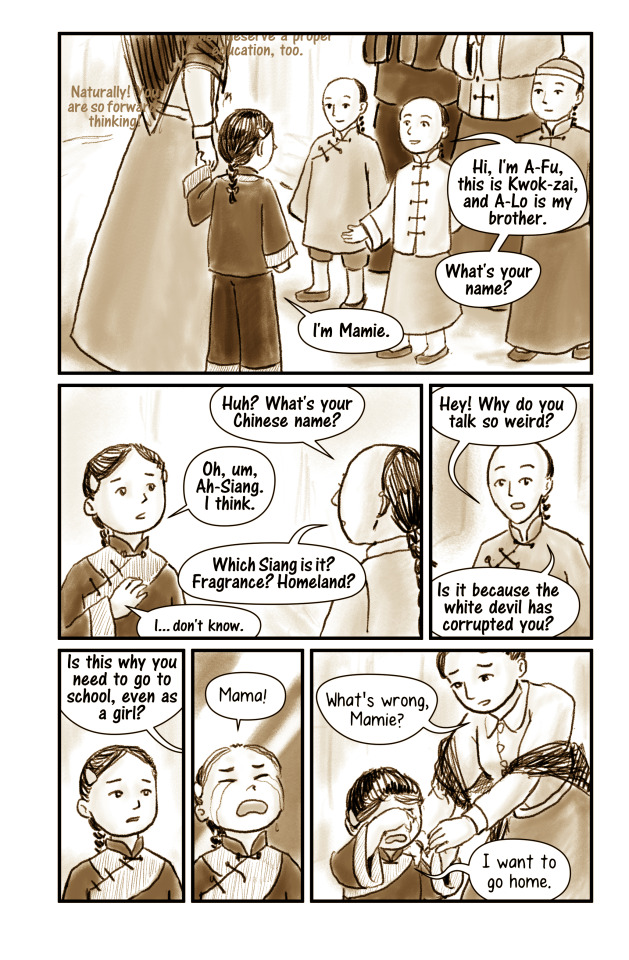
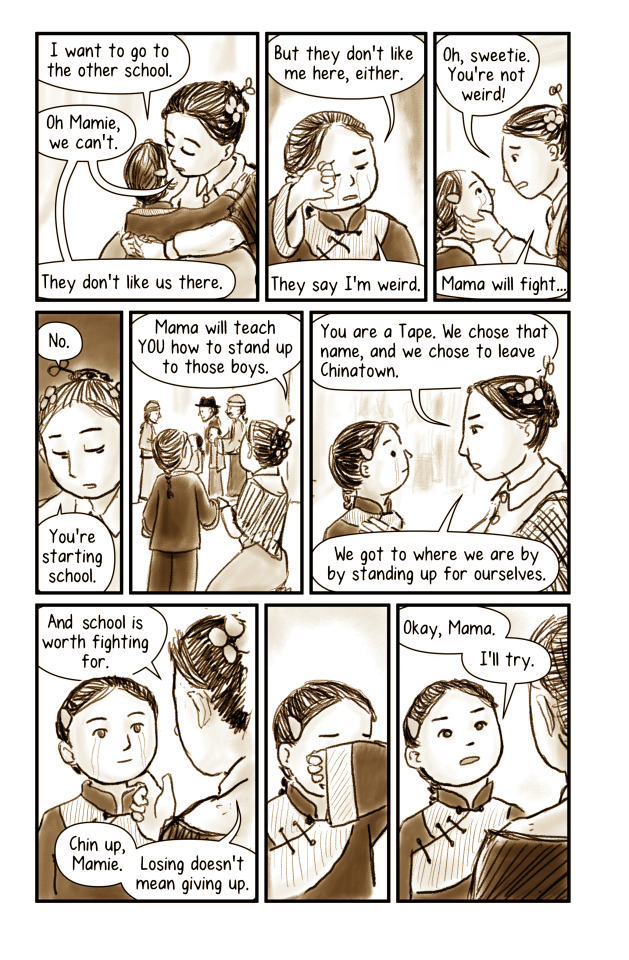
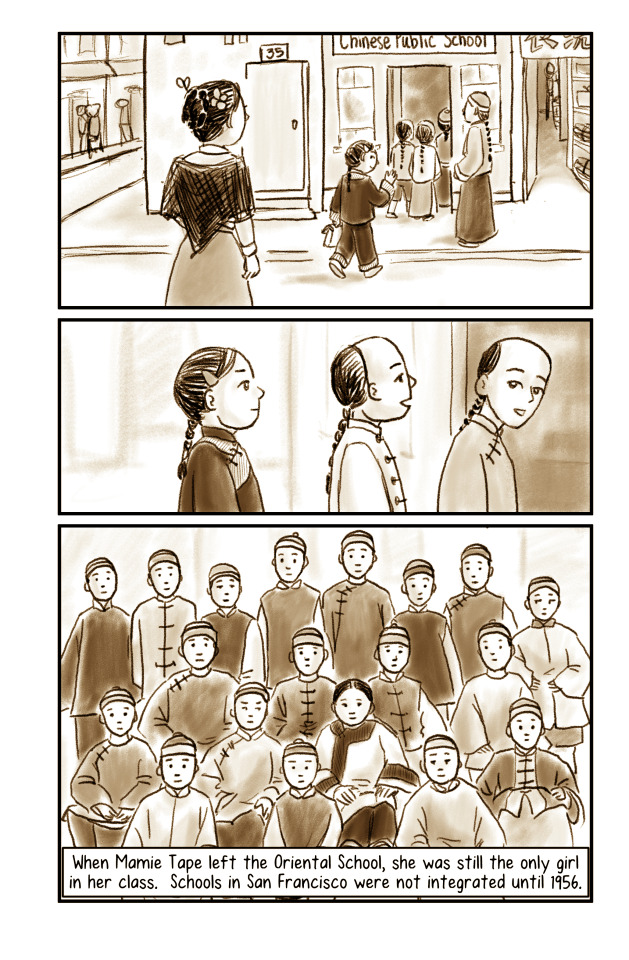
Historical Notes
Mary and Joseph Tape were not born in America, but their names and identities were very much formed in America. Joseph Tape was born Jeu Dip in Guangdong, China, immigrated the America when he was twelve, and spent his teenage years working as a house servant in an Irish household. Mary arrived in America at the age of eleven, and was found and raised as Mary McGladery in a Protestant orphanage as the only Chinese child amongst ~80 children. Both Mary and Jeu spent their formative years amongst White Christian families, so when Jeu Dip and Mary married in 1875, little wonder that Jeu picked the English name of Joseph Tape -- Joseph to match with Mary, and the German last name Tape as a nod to his former name of Dip.
The Tape family lived about 14 blocks outside of Chinatown, in a primarily white neighborhood. They dressed in Western clothing, spoke English at home, and Mamie grew up playing with non-Chinese kids. Naturally, they wanted their children to attend the local elementary school, a mere 3 blocks from their home. The principal, Ms. Hurley, denied her entrance, claiming that she was “filthy and diseased.” At the time, there was no public school option for Chinese children -- the 1870 state law stipulated separate schools for “African and Indian children” only, not Chinese. The Tape family, with the help of the Chinese Six Companies, their church, and the Chinese consulate, decided to sue, claiming that the 1880 California school code guaranteed everyone a right to public education and that this was a violation of the 14th Amendment.
They won.
But this was 1885, three years after the passage of the Chinese Exclusion Act and six years before Plessy v Ferguson. Regardless of what the California Supreme Court might decide, public sentiment was on the side of the San Francisco school district. Determined to keep out this “invasion of Mongol barbarism”, the California State Legislature passed a law permitting separate schools for Chinese children, which then allowed Principal Hurley to reject Mamie Tape once more.
While Mamie was rejected from the Spring Valley Elementary School for being Chinese, she also had a hard time fitting in to the Chinese public school. The Chinese merchants saw Western education as something primarily for boys. (Their girl children learned from their mothers at home.) Mamie, a girl dressed in Western clothes, would have stood out like a sore thumb. The final panel of the comic was based on a photo from three years later, and even then, Mamie was the only girl.
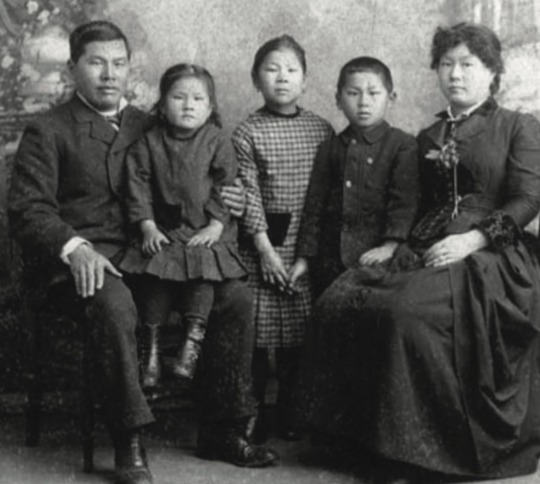
Places where I fudged the history: Frank, Mamie’s younger brother, was actually six years old and should have been more present in the comic, but I wante to keep the focus on Mamie and Mary. Also, Mamie had actually shown up to her first day of school in Western clothes. An earlier draft of the comic had a separate arc involving Mamie feeling rejected at school and Mary buying her some Chinese clothes, but that got too long and complicated.
Much of this was drawn from Mae Ngai’s book about the Tape family and their experiences as 2nd and 3rd generation Chinese Americans, titled “The Lucky Ones.”
----------
Here is Mary Tape's letter to the San Francisco School Board, 1885:
1769 Green Street.
San Francisco, April 8, 1885.
To the Board of Education -
Dear Sirs: I see that you are going to make all sorts of excuses to keep my child out off the Public schools. Dear sirs, Will you please to tell me! Is it a disgrace to be Born a Chinese? Didn’t God make us all!!! What right have you to bar my children out of the school because she is a chinese Decend. They is no other worldly reason that you could keep her out, except that. I suppose, you all goes to churches on Sundays! Do you call that a Christian act to compell my little children to go so far to a school that is made in purpose for them. My children don’t dress like the other Chinese. They look just as phunny amongst them as the Chinese dress in Chinese look amongst you Caucasians. Besides, if I had any wish to send them to a chinese school I could have sent them two years ago without going to all this trouble. You have expended a lot of the Public money foolishly, all because ofa one poor little Child. Her playmates is all Caucasians ever since she could toddle around. If she is good enough to play with them! Then is she not good enough to be in the same room and studie with them? You had better come and see for yourselves. See if the Tape’s is not same as other Caucasians, except in features. It seems no matter how a Chinese may live and dress so long as you know they Chinese. Then they are hated as one. There is not any right or justice for them.
You have seen my husband and child. You told him it wasn’t Mamie Tape you object to. If it were not Mamie Tape you object to, then why didn’t you let her attend the school nearest her home! Instead of first making one pre tense Then another pretense of some kind to keep her out? It seems to me Mr. Moulder has a grudge against this Eight-year-old Mamie Tape. I know they is no other child I mean Chinese child! care to go to your public Chinese school. May you Mr. Moulder, never be persecuted like the way you have persecuted little Mamie Tape. Mamie Tape will never attend any of the Chinese schools of your making! Never!!! I will let the world see sir What justice there is When it is govern by the Race prejudice men! Just because she is of the Chinese decend, not because she don’t dress like you because she does. Just because she is descended of Chinese parents I guess she is more of a American then a good many of you that is going to prewent her being Educated.
Mrs. M. Tape
#original comic#chinese american history#legal history#turns out there's a lot of chinese american court cases#that i have a lot of feelings about#my comic#mine
1K notes
·
View notes
Text
esther eng- openly lesbian filmmaker!!
i just found out about esther eng (伍錦霞) the first chinese female filmmaker to make chinese language films in the us and hong kong.
her love for films started from watching cantonese operas!! she made many films in her lifetime, its such a shame most of the films she made are now lost films, except for two films: golden gate girls and murder in new york chinatown.
she was a butch lesbian and there was no controversy around that because in cantonese opera its normal for actors and actresses to crossdress. another fact that made me smile so much is that her grandparents came from toisan (台山)!!! literally punching the air rn bc im from toisan, i speak cantonese and im also a lesbian i am literally so happy.
i also loved how people called her by the nickname "霞哥" ("ha brother" in english)
i literally cannot express how much finding out about esther eng made my day
also if your interested this is the article i read


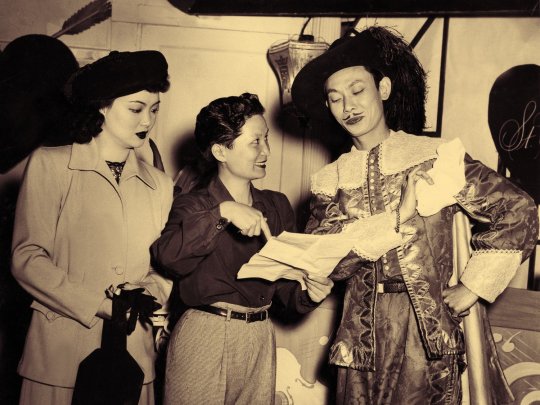
#lesbian#butch lesbian#butch#chinese lesbian#wlw#lesbian history#lgbtq history#chinese lgbtq#chinese american history#chinese american#taishan#toisan#台山#cantonese#cantonese opera#hong kong cinema#lgbt cinema#taishanese americans#chinese filmmaker#chinese film#lgbtq cantonese#esther eng#伍錦霞#lgbt chinese history#1930s film
182 notes
·
View notes
Text

The " Chinese Andrews Sisters" - The Kim Loo Sisters were an American jazz vocal quartet popular during the swing era, the sisters began their careers as child entertainers in Minneapolis, Minnesota . During the Second World War they appeared on the Broadway stage and the Hollywood screen with actors including Frank Sinatra and were arguably the first Asian American act to star in Broadway musical revues.
Their father was Chinese from Guangzhou, Guangdong. Their mother was Polish from Buczacz, Poland, now Ukraine.
The Kim Loo Sisters made the transition from stage to screen with the Hollywood feature films. One of these, “Gee! The Jeep Jumps” was selected by the Library of Congress for their film archive.
Currently a musical about the lives of the sisters is being produced in St Paul Minnesota at the History Theater, a co production with Theater Mu
youtube
*not to be confused with The Kim Sisters who were a Korean-born American female vocal group who made their career in the US during the 1950s and 1960s
#chinese american musicians#swing#big band era#world war 2#music of world war 2#chinese american history#minneapolis#minnesota#minnesota musicians#kim loo sisters#musicals#theater mu#Youtube
2 notes
·
View notes
Text
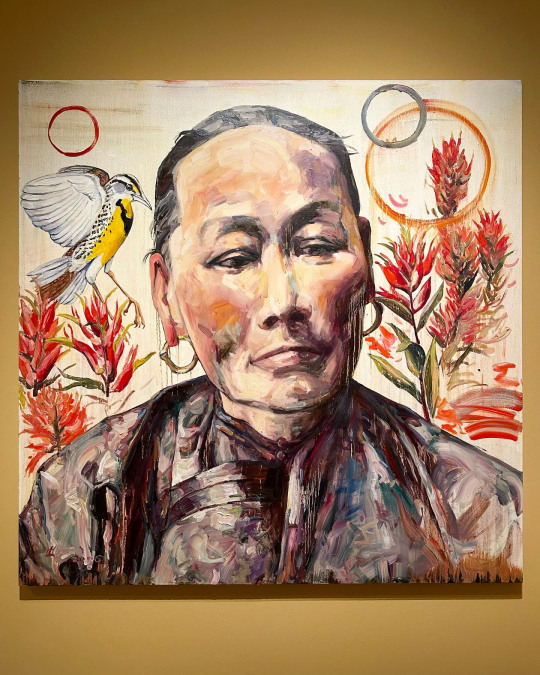
(Hung Liu “Portrait of China Mary”, 2006, Oil on canvas)
Currently at The James Museum in St. Pete, is From Far East to West: The Chinese American Frontier, an informative show that includes many beautiful paintings. There’s so much history in America that often doesn’t get taught in school. This is a great opportunity to learn about this immigration story through artwork as well as text.
From the museum about the exhibition-
While European American settlers gradually pushed the United States frontier westward throughout the 1800s, the West coast of the country was developing independently as well. Accelerated by the discovery of gold mid-century, the population boom included Chinese immigrants who crossed the Pacific Ocean to California.
Most 19th century Chinese immigrants came to their new country from the coastal Canton region (province of Guangdong today) in southeastern China. Starting over on a different continent away from familiar surroundings and culture would be challenging, but for many decades anti-Chinese hostility and exclusion laws made settling in the United States even more difficult. The achievements of Chinese immigrants paved a path for future generations and are a testament to strength and perseverance.
The foundation for the exhibition highlights narratives of Chinese America from the 1850s to the 1930s. The paintings-all created by Chinese Americans in the 21st century-reflect inspiration from this history. The painters are also fueled by their own, more recent immigration stories to the United States after China’s Cultural Revolution (1966-1976) and their rigorous art training in the government-sponsored movement of Socialist Realism. After China opened to the rest of the world in the late 1970s, many Chinese artists-like Mian Situ, Jie Wei Zhou, Benjamin Wu, Hung Liu, and Z.S. Liang, all featured here were inspired to immigrate to the United States in search of greater opportunity.
Here, these artists’ historical interpretations speak to culture, identity, community, and resilience. Related objects and ephemera from the period support these stories. From the Gold Rush to Angel Island, this exhibition reveals often overlooked but significant contributions and perspectives of Chinese immigrants that deepen our understanding of U.S. history.

Hung Liu “Dandelion with Small Bird”, 2017 Mixed media
About the above painting from the museum-
Dandelions and their fluffy seed pods can be found anywhere in the world and thrive wherever they land. Their migratory nature allows them to survive a journey across vast lands even across oceans and take root anywhere in the world. For Liu, the dandelion represents her own tenacity and ability to thrive in the face of adversity.
The dandelions, fragile in nature and tattered by the lightest breeze, mimic how images, and personal narratives, too, can be scattered by time and the winds of history —as well as by the rhythms of feast and famine …
–Hung Liu

Mian Situ “Blasting a Route Through the Sierra Nevada, 1865, Central Pacific Railroad”, 2018, Oil on canvas

Mian Situ “The Gold Seekers , Chinese Camp, 1850”, 2015, Oil on canvas

Jie Wei Zhou “Dragon Parade”, 2012, Oil on Linen
This exhibition is on view until 1/28/24.
#Art#The James Museum#Hung Liu#Art Shows#Chinese American History#Mian Situ#Chinese Americans#Florida Art Shows#Gold Rush#Jie Wei Zhou#Z.S. Liang#Benjamin Wu#St. Pete Art Shows#The James Museum of Western and Wildlife Art#Historical Painting#History#Immigration#Painting#Transcontinental Railroad
3 notes
·
View notes
Photo
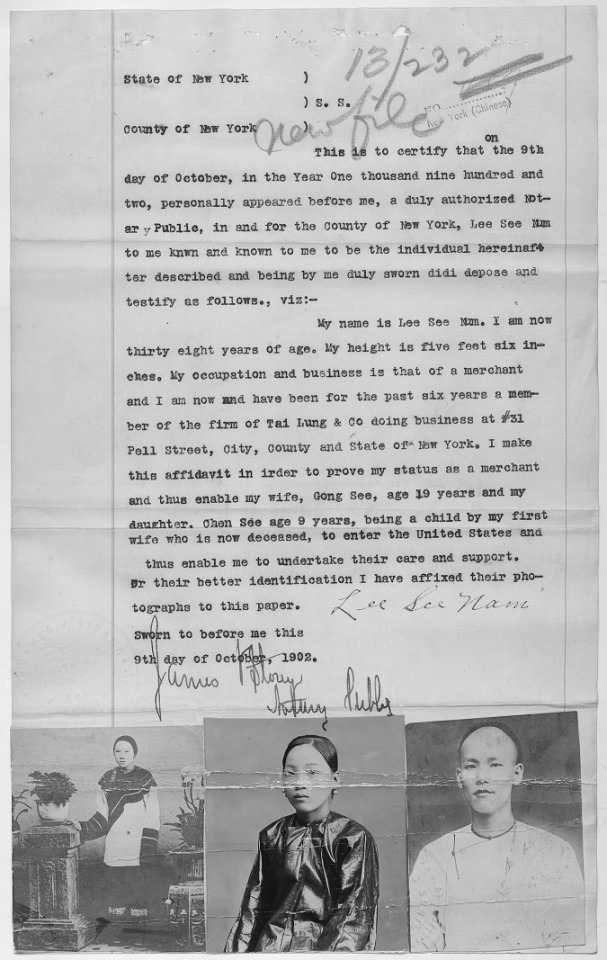
“I make this affidavit in [order] to prove my status as a merchant and thus enable my wife, Gong See, age 19 years and my daughter, Chen See age 9 years, being a child by my first wife who is now deceased, to enter the United States . . . .” 10/9/1902.
File Unit: Case File 12/232: Gong See and Chen See, 10/9/1902 - 8/16/1940
Series: Chinese Exclusion Act Case Files, ca. 1882 - ca. 1960
Record Group 85: Records of the Immigration and Naturalization Service, 1787 - 2004
Transcription:
State of New York )
) S. S.
[stamped] NO [number struck through]
County of New York ) [New York (Chinese) [/stamped]
[handwritten in pencil in upper part of document] 13/232 New file [/handwritten]
This is to certify that on the 9th day of October, in the Year One thousand nine hundred and two, personally appeared before me, a duly authorized Notary Public, in and for the County of New York, Lee See Nam to me known and known to me to be the individual hereinafter described and being by me duly sworn didi depose and testify as follows., viz:-
My name is Lee See Nam. I am now thirty eight years of age. My height is five feet six inches. My occupation and business is that of a merchant and I am now and have been for the past six years a member of the firm of Tai Lung & Co doing business at #31 Pell Street, City, County and State of New York. I make this affidavit in irder [sic] to prove my status as a merchant and thus enable my wife, Gong See, age 19 years and my daughter, Chen See age 9 years, being a child by my first wife who is now deceased, to enter the United States and thus enable me to undertake their care and support. For their better identification I have affixed their photographs to this paper. [handwritten] Lee See Nam [/handwritten]
Sworn to before me this
9th day of October, 1902.
[handwritten] James [illegible initial] Story [/handwritten]
[handwritten] Notary Public [/handwritten]
[At bottom of page are individual photos of Lee See Nam, Gong See, and Chen See.]
#archivesgov#October 9#1902#1900s#Chinese Exclusion Act#Chinese American history#Asian American history#immigration
51 notes
·
View notes
Text

"Conceived as a multifaceted cultural history, Like Water tells the story of the making of Bruce Lee as a transpacific icon. Foregrounding the larger geopolitical and cross-cultural forces at work, Daryl Joji Maeda tracks Lee’s incessantly migratory footsteps from his on-the-road birth at a Chinese hospital in San Francisco to his mysterious death at his paramour’s pad in Hong Kong. As a cultural history, the book is rich and expansive, compiling a montage of big subjects such as Chinese immigration, Cantonese opera in America, and the history of Chinese cinema. As a biography, Like Water draws the contours of Lee’s life while highlighting flashpoints of his legend."
#uwlibraries#history books#chinese american history#biography#history of film#american history#asian american history
1 note
·
View note
Text
0 notes
Text

Most depictions of Chinese transcontinental railroad workers have a bunch of humble looking guys in conical straw hats all wearing the same baggy shirt carrying buckets or dynamite or whatever.
I love that this one has this dude who is HELLA JACKED swinging a sledgehammer the force of which sends his queue flying into the air. Dude next to him in Mr T's vest armed with guns for days while smoking a pipe. 10/10.

#transcontinental railroad#representation#trains#chinese americans#chinese american history#asian americans#asian american history#hella jacked
1 note
·
View note
Text

A Trinity of Dragons: Fire, Earth, and Water, Rookwood Pottery Co., 1892
#art#art history#ceramics#pottery#dragons#Chinese dragons#Rookwood Pottery Company#American art#19th century art#Cincinnati Art Museum
625 notes
·
View notes
Photo

“ Mississippi Triangle is a 1983 documentary about the Black, white, and Chinese communities in the Mississippi Delta region, which I rewatched the other day, prompted by a message from a friend. It is one of a plethora of works in film and art that show, contrary to popular perception, that the South has never had just two racial groups. “
Imani Perry, The Atlantic June 10, 2022
(via Lessons From Black and Chinese Relations in the Deep South)
1 note
·
View note
Text


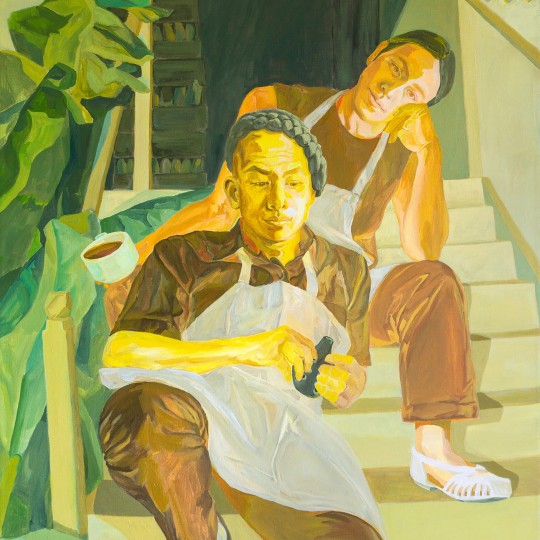
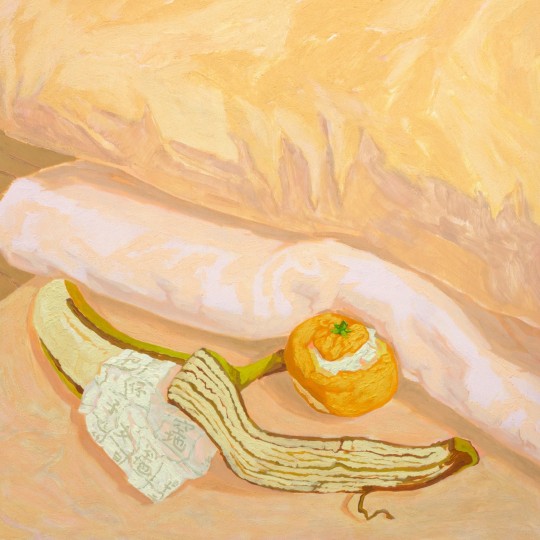
Being drawn to colours that they “associate with sunrise and sunset-times of transition and daily possibility” Livien Yin's paintings have an awe-inspiring palette and such a delicate, considered finish. “I try to render the way that sunlight feels against the skin, like a caress of the subjects in the painting.” Another recognisable quality of the artists work is their repetition of imagery, specifically hands and fruit. Sometimes the hands frame the face of the subject, and the fruit lies half eaten. And, sometimes the two images come together – a model's hands lazily peel an orange, another clasps an apple, mid-bite.
Livien Yin explains that their focus on hands is a means a of referencing both manual labour that characterised the first major wave of Chinese immigration and their connection to Chinese culture and cooking; “I like to paint hands to commemorate the cultural legacies and ‘acts of care’ passed down from the generations before us.” Whereas the fruit has a more specific reference – “when ‘paper sons and daughters’ were preparing to be interrogated at Angel Island Immigration Station, they memorised the details of their new identities using something called ‘coaching notes’ which were sometimes secretly sent to them inside fruit.” And, simultaneously, when placed in the hands of women, Livien intends for it to be a metaphor for sexual agency.
on Livien Yin
#art#livien yin#art moodboard#art detail#art curator#artblr#art academia#chinese american art#love is stored in the kitchen#oranges#aesthetic#moodboard#light academia#romantic academia#art history#chinese art#oil painting#acrylic painting
4K notes
·
View notes
Text
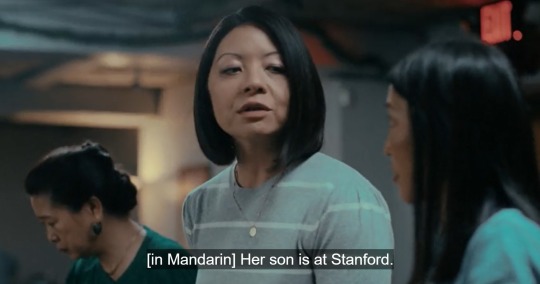
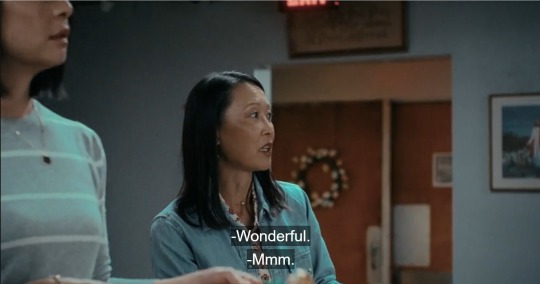
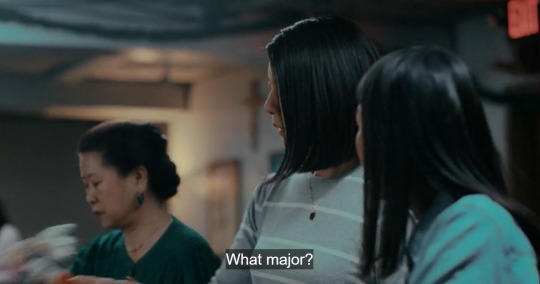
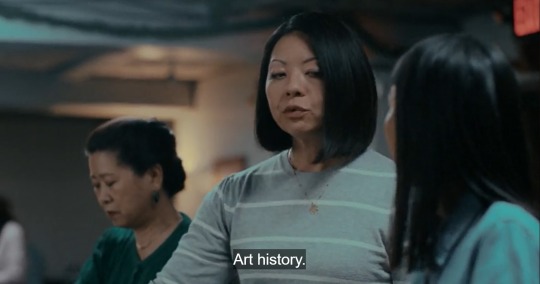
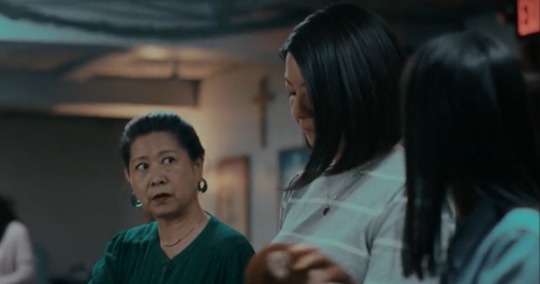

This is so accurate. I'm screaming ajksalsajs
#as an asian who decided to major in history in undergrad#and had to argue with my parents over it#this made me laugh#american born chinese#I started watching this a couple days ago and i'm really enjoying it
407 notes
·
View notes
Text
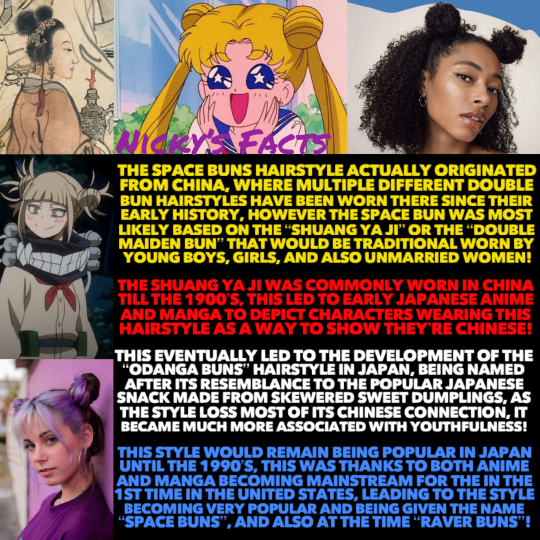
Space Buns are so cute and give us such a doll like look, regardless if were in 2d or 3d!💜
🇨🇳🇯🇵🇺🇸
#history#space buns#odango#shuang ya ji#hairstyle#chinese history#anime#manga#art#united states#japanese history#girly things#girly aesthetic#coquette#dollete style#china#american history#just girly things#soft girl#90s#anime style#animation#femininity#pop culture#1990s#cultural exchange#nickys facts
314 notes
·
View notes
Text
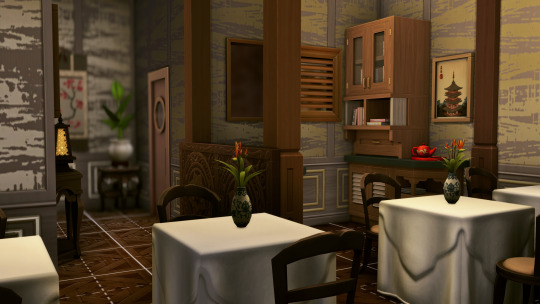

no one, absolutely no one: .....
me: ...i think i need to build a 1920s Chinese restaurant...
#anyone else obsessed with the history of american chinese food? just me? cool#absolutely need to rename edwardian promenade because i have just fully leaned into the 20s vibes#ts4 wip#sims 4 wip#wip
78 notes
·
View notes
Text
youtube
Hey... psst... hey you... do you like museum tours? Walk-throughs? Well, you're gonna love this new video I made. Yeah, it's pretty good. I mean, the video quality is shit when it's trained on me, but the footage of the museum is good, and I think my commentary is interesting. Yeah, I think you'd enjoy it, make a cup of tea, and grab a snack for while you watch it. Great, thanks!
#history#museum#archaeology#youtube#chinese history#canadian history#american history#museums#art history#dark academia
86 notes
·
View notes
Text
And I wish people would stop shit posting media before even giving it a chance. I’ve seen so many negative posts just based on posters and trailers. Give me a break.
The moment a movie or show stars a minority or a woman all the long-winded thinkpieces and whataboutism pop up.
147 notes
·
View notes